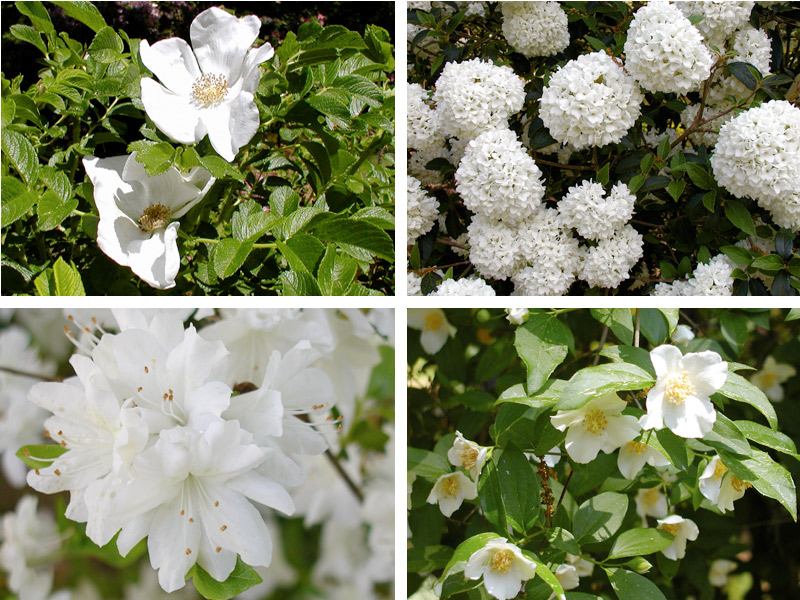The Garden Speaks in Colors
 Saturday, April 24, 2010 at 6:00AM
Saturday, April 24, 2010 at 6:00AM The garden speaks to us in colors — green, white, blue, yellow, and pink — and draws our emotions into itself. Traditionally, colors say something to us, and maybe that is why we respond so strongly to the arrival of spring. The garden is hushed in winter, but its voice sings out with the new season.
Many shades of green push through gray branches and brown soil to announce rebirth and renewal. One can stand in the garden and feel the optimism of spring, the soothing reassurance that life endures.
This April view from the patio features the fresh green foliage of roses, weeping Japanese maple, and daylily.
 Clockwise from top left: leaves of dogwood, cornus florida; variegated hydrangea, macrophylla Variegata; Japanese painted fern, Athyrium niponicum var. pictum; hosta 'Francis Williams'
Clockwise from top left: leaves of dogwood, cornus florida; variegated hydrangea, macrophylla Variegata; Japanese painted fern, Athyrium niponicum var. pictum; hosta 'Francis Williams'
The purity of spring impresses us, its newness untouched by disease or wear or damages of time. White shines in the garden, fresh and clean. In the garden I am young and my soul eternal.
 The blossoms of Philadelphus coronarius, sweet mock orange or English dogwood, light up this area adjacent to the lady garden.
The blossoms of Philadelphus coronarius, sweet mock orange or English dogwood, light up this area adjacent to the lady garden. Clockwise from top: Rosa rugosa var. alba; Viburnum macrocephalum; closer view of Philadelphus coronarius; Azalea, snow white
Clockwise from top: Rosa rugosa var. alba; Viburnum macrocephalum; closer view of Philadelphus coronarius; Azalea, snow white
The garden speaks of peace, too, with images of blue. Cares are light in this place, and for a time they fly away and leave our hearts at rest.
The daffodils ars spent, but blue phlox divaricata still blooms in the front garden.
 Clockwise from top left: Mr. Bluebird stands guard at his home near the lady garden; Oregon grape, mahonia aquifolium; Hosta sieboldiana elegans; a lizard with a touch of blue lives in this planter on my patio.
Clockwise from top left: Mr. Bluebird stands guard at his home near the lady garden; Oregon grape, mahonia aquifolium; Hosta sieboldiana elegans; a lizard with a touch of blue lives in this planter on my patio.
All the golden hues of the garden, the yellows and oranges, represent energy, comfort and pure joy. Smile, for there is much to smile about in the garden.
 For many years this lone tulip has returned each spring to the front garden. I am always happy to see it, for most tulips don't survive in my climate.
For many years this lone tulip has returned each spring to the front garden. I am always happy to see it, for most tulips don't survive in my climate. Clockwise from top left: Pansies are still blooming; golden oak pollen covers this yellow sedum; variegated leaves of Cherokee Red dogwood; foliage of caryopteris 'Jason'
Clockwise from top left: Pansies are still blooming; golden oak pollen covers this yellow sedum; variegated leaves of Cherokee Red dogwood; foliage of caryopteris 'Jason'
And then there is pink, a color that speaks of friendship. Is a garden complete, if there is no one with which to share it? Come with me, my friend. Let us walk together and listen to what the garden has to say.This very old urn belonged to my parents. Behind it is dianthus 'Bath's Pink'.
Clockwise from top left: pink fringe-like flowers of lorapetalum; Azalea 'George Lindley Tabor'; unknown flower growing in the lady garden; Rosa mutabilis
You may also like No Skeletons at This Party.

